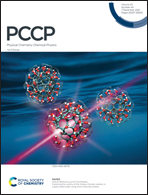How DNA affects the hyperthermophilic protein Ape10b2 for oligomerization: an investigation using multiple short molecular dynamics simulations†
Abstract
Alba2 is a hyperthermophilic DNA-binding protein, and DNA plays a crucial role in the Alba2 oligomerization process. It is a pity that there is limited research in terms of how DNA affects the conformational change of Alba2 in oligomerization. Herein, we complement the crystal structure of the Ape10b2 (belongs to Alba2)–dsDNA complex (PDB ID: 3U6Y) and employ multiple short molecular dynamics (MSMD) simulations to illuminate the influence of DNA on Ape10b2 at four temperatures (300, 343, 363, and 373 K). Our results indicate that DNA could cause the conformational changes of two important regions (loop1 and loop5), which may be beneficial for protein oligomerization. The results of hydrogen bond analysis show that the increasing number of hydrogen bonds between two monomers of Ape10b2 may also be a favorable factor for oligomerization. In addition, Ape10b2 can stabilize DNA by electrostatic interactions with an increase in temperature, and five residues (Arg40, Arg42, Asn43, Asn45, and Arg46) play a stabilizing role during protein binding to DNA. Our findings could help in understanding the favorable factors leading to protein oligomerization, which contributes to enzyme engineering research from an industrial perspective.



 Please wait while we load your content...
Please wait while we load your content...